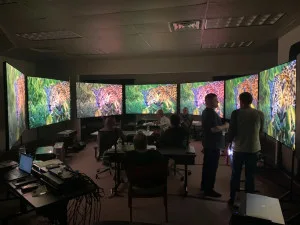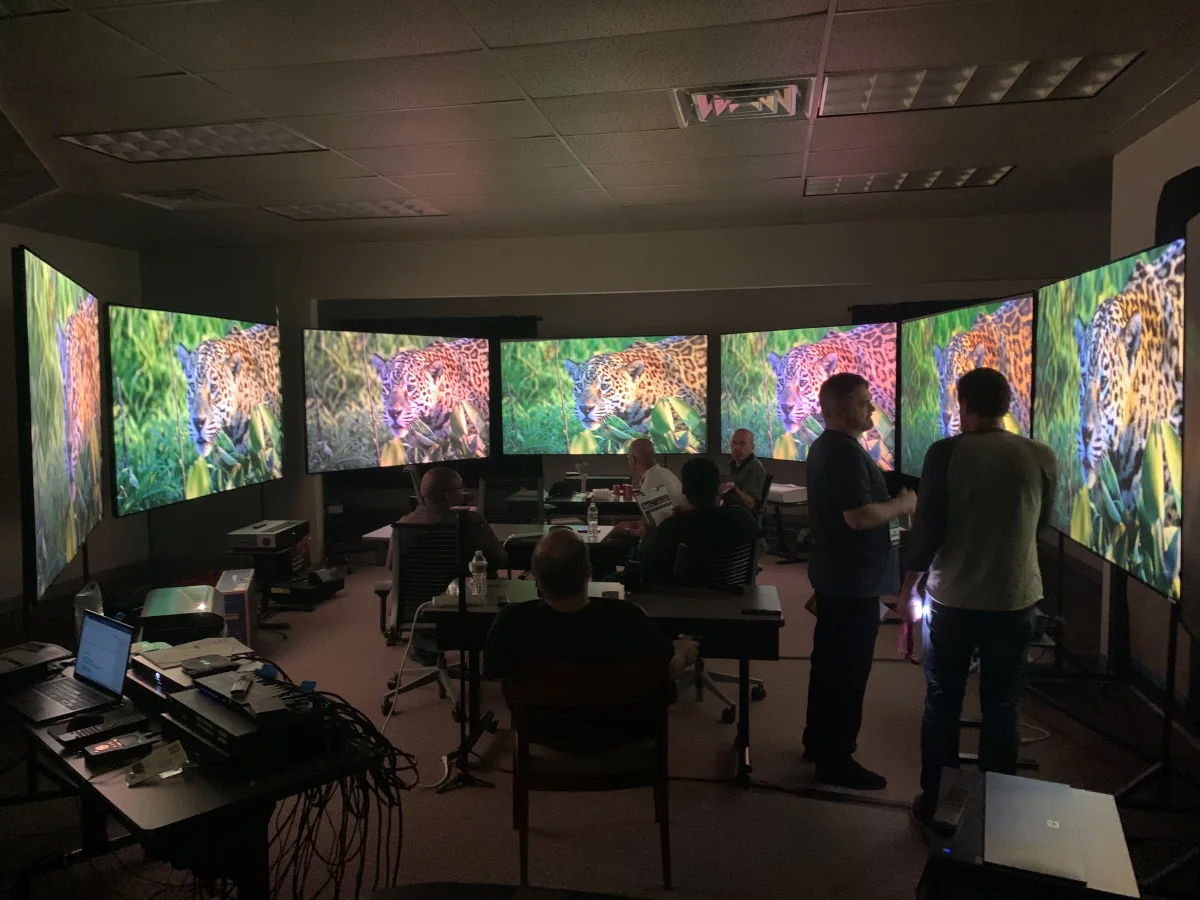I recently saw a report on a shoot-out of Ultra Short Throw projectors that was conducted in the US by ProjectorScreen.com (a high end specialist retailer) and ProjectorCentral.com. I didn’t get there (I’m on the wrong continent) but caught up with Brian Gluck of ProjectorScreen.com to get more background.

The motivation of the tests was not really to crown a ‘King of projectors’ as the Value Electronics shoot outs (In 19th Value Electronics TV Shoot-Out, OLEDs Win) try to do, but to raise the awareness of the category and to highlight how the luminance performance and lifetime of sets now makes them a realistic alternative for TV applications. Direct view TV is now the reference for image quality for all displays, apart from a few real enthusiasts for a ‘celluloid look’ (who even go as far as watching in black hoodies to maximise on-screen contrast by minimising reflections!)
It also was intended to help consumers understand that, especially with UST projectors, the screen is a critical part of the display system. If you use one with a screen with no directionality, the ‘hot spot’ tends to show on the ceiling. Those that really want a very high resolution regular screen can even go as far as to make sure that a black ceiling absorbs as much of the light as possible. Gluck is a fan of Aegis AV Cabinets from Texas for integrating UST projectors into domestic environments.
The ‘UST projector sold with a screen’ was a trend that started in China. Hisense was the pioneer and was followed by Formovie. The product ‘clicked’ for Hisense, Gluck told me, and the firm has very much positioned each of the projectors as designed for just one size of screen. Gluck said that sometimes this limited sales, where buyers wanted something different, so new products will have a bit more variation
ProjectorScreen provided the premises and projectors while Rob Sabin of Projector Central supervised the technical set-up – although ProjectorScreen’s own ISF-certified calibrator, Dave Harper, did the dark room tests. Projector Central chose the judges and set the criteria for the evaluation. There were eight single laser sets in the shoot-out and six ‘triple laser’ sets. (The single laser sets use a blue laser and a laser phosphor wheel to create the three primaries).
A number of the projectors used engines from Appotronics of China, which was the originator of the laser phosphor technology. However, as Gluck highlighted, there’s a big difference between software and processing that can really influence the performance of the set as a whole. (We have heard rumblings that Appotronics, which has its own brands (including Formovie, which it runs with Xiaomi) as well as supplying under OEM, has some ‘secret sauce’ for optimising its own sets, but, of course, we can’t confirm that – although it wouldn’t be a surprise if its engineers know more about the pros and cons of the engines than its customers). The Vava unit had a good engine, but was let down by weak software and processing.
As well as the Appotronics engines, there were more than one using Hisense systems and LG and Samsung have their own approaches. The two Korean makers have larger DLP chips and that really helps the performance, with the Samsung registering 2,300:1 contrast.
Most of the units used DLP chips, but, as you would expect, Epson used a 3LCD engine. Gluck told us that it seemed very much as though Epson had developed the home entertainment version from a commercial chassis, so some areas such as the throw distance and poor speakers let it down, while it did have the lowest latency (17ms) and, of course, with three imagers had no rainbow effects.
Some brands, such as the Fengmi unit, have a big online following, but Gluck is not always sure why, especially as it didn’t have colour management so it was hard to modify, although it now has that facility.
I asked Gluck about a promotion that Hisense ran in the US a couple of years ago, when it gave a ‘no questions asked’ return period on new UST sets. He said that it did raise interest as it took away the risk element of something new, but while the projectors could be refurbished, he was not sure about the screens which are relatively fragile and not easy to ship or collect.
To act as a reference, a JVC NZ8 D-ILA projector with a Stewart Studiotek 130 screen was set up in an adjoining room to act as a reference. Content was available from a Kaleidascape server.
Each laser TV was paired with an identical 100″ Spectra Projection Vantage ambient light rejecting screen engineered to work with UST projectors.
Judging
Judges were given ballot sheets to rate each projector for specific attributes of picture quality, such as Colour Accuracy, Contrast, Black Level/Shadow Detail, and Detail/Sharpness. For tabulation, the highest grade within each attribute was assigned a score of 10 and all other scores are relative, making the final result a pure ranking with the spread between each projector retained. There was no marking vs the JVC.
Additionally, some picture quality attributes were given different weights to reflect their importance to overall image quality with motion handling, 4,000-Nit Tone-Mapping, and Color Gamut given less weight than those related to color accuracy, contrast and black level.
Pricing was not taken into account.
The Resuts
Anyway, <fx:drumroll>. the winner in the Triple laser category was the Formovie Theater, which was not only ranked as the best, but was also the cheapest at $2,999. It was also the only unit to support Dolby Vision The ranking was
- Formovie Theater (winner)
- LG HU915QB
- Hisense PX1-PRO
- Samsung LSP9T
- AWOL Vision LTV-3500
- VAVA Chroma
In the single laser category, the ranking was:
- BenQ V7050i (winner)
- Hisense 100L5G
- ViewSonic X2000B-4K
- Epson LS500
- XGIMI Aura
- LG HU715Q
- Samsung LSP7T
- Optoma P2
Gluck highlighted the progress in the quality of the sets – the Optoma P1 had been the best in the past, but this time the P2 came last.
You can find a short video on the test process here. (BR)


